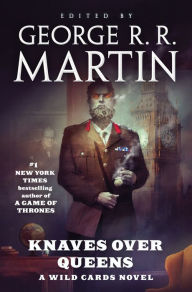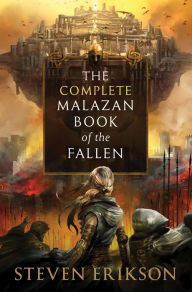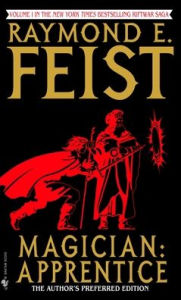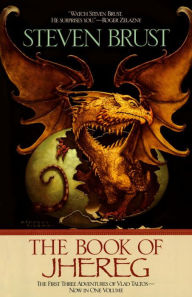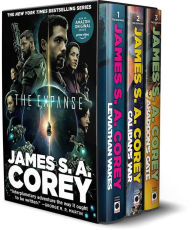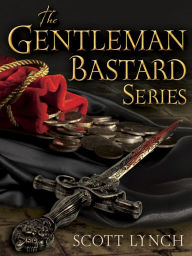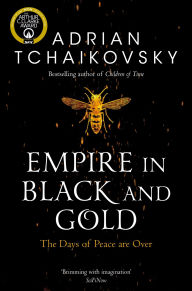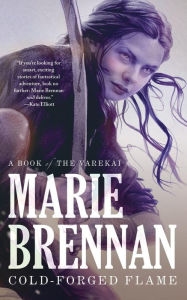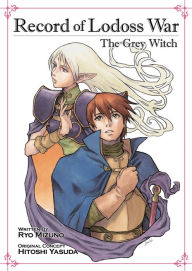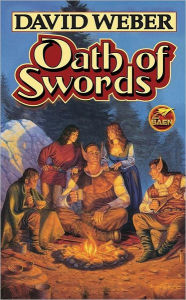10 Science Fiction & Fantasy Novels Based on RPG Campaigns

For a long time, role-playing games (RPGs) like Dungeons & Dragons were as much a punchline as an outlet for the imaginations of their dedicated fans—the source of unfair stereotypes of fantasy enthusiasts as folks better left to themselves in their parents’ basements. But like many other pillars of geek culture, RPGs have been making major waves in the mainstream for a while now, helped along by the wider acceptance of pop fantasy fare and explicit, no longer defamatory recognition of the game across a wide swath of media and pop culture. Along the way, entire new subgenres have arisen out of this increasing popularity, from comics based on actual-play gaming podcasts to the “replay novels”—essentially transcripts of well-run RPG campaigns)—popularized in Japan.
Unsurprisingly, science fiction and fantasy writers were way ahead of this curve: though it has been used as an accusation or an insult at times, it’s undeniable that there are those authors who have written successful book series based on their own personal RPGs campaigns—and more of them than you might think. (Note: The list below explores original novels only, excluding the many excellent licensed books based on games like Dungeons & Dragons and Pathfinder.)
Knaves Over Queens: A Wild Cards Novel (Book One of the British Arc)
Knaves Over Queens: A Wild Cards Novel (Book One of the British Arc)
By
Wild Cards Trust
Editor
George R. R. Martin
Hardcover $29.99
Wild Cards, by George R.R. Martin and Seemingly Every Working Genre Author Alive
Wild Cards is a shared universe saga spanning 27 books, more than a dozen short stories, and adaptations ranging from comics, to metafictional web sites, to a brewing television series (currently in development for Hulu). It is a whole thing, and it all started when George R.R. Martin received the RPG Superworld as a gift and began running campaigns for a group of friends in New Mexico. By the time they had a few campaigns under their belts, Martin thought they had collectively created a fantastic story—a fictional world worth exploring alongside readers. Thus was born the firstWild Cards anthology. Set in a universe where an alien virus has struck New York, killing the majority of those exposed, afflicting others with grotesque mutations (they become known as “Jokers”), and transforming the select few remaining into super powered ‛”Aces,” one of the goals of the shared universe’s founding was to reject the non-permanent continuity of comic book superheroes. As a result, the Wild Cards universe is a complicated one, and has only grown more complex over the decades through the contributions of first-rate SFF writers like Martin, Pat Cadigan, Melinda Snodgrass, Carrie Vaughn, Daniel Abraham, Roger Zelazny, and countless others.
Wild Cards, by George R.R. Martin and Seemingly Every Working Genre Author Alive
Wild Cards is a shared universe saga spanning 27 books, more than a dozen short stories, and adaptations ranging from comics, to metafictional web sites, to a brewing television series (currently in development for Hulu). It is a whole thing, and it all started when George R.R. Martin received the RPG Superworld as a gift and began running campaigns for a group of friends in New Mexico. By the time they had a few campaigns under their belts, Martin thought they had collectively created a fantastic story—a fictional world worth exploring alongside readers. Thus was born the firstWild Cards anthology. Set in a universe where an alien virus has struck New York, killing the majority of those exposed, afflicting others with grotesque mutations (they become known as “Jokers”), and transforming the select few remaining into super powered ‛”Aces,” one of the goals of the shared universe’s founding was to reject the non-permanent continuity of comic book superheroes. As a result, the Wild Cards universe is a complicated one, and has only grown more complex over the decades through the contributions of first-rate SFF writers like Martin, Pat Cadigan, Melinda Snodgrass, Carrie Vaughn, Daniel Abraham, Roger Zelazny, and countless others.
The Complete Malazan Book of the Fallen
The Complete Malazan Book of the Fallen
In Stock Online
eBook $107.12
The Malazan Book of the Fallen, by Steven Erikson and The Malazan Empire Series, by Ian C. Esslemont
Back in the 1980s, Steven Erickson and Ian C. Esslemont grew frustrated with the fussy rules of most RPGs, and turned to the Generic Universal Role-Playing System (GURPS) to craft a more free-form gaming experience. That effort led to the creation of the Malazan world, which would ultimately becoming the setting for lengthy, intertwining series of novels from both authors. What’s really interesting about the Malazan books is that all sixteen books to date—Erikson’s The Malazan Book of the Fallen and Esslemont’s The Malazan Empire—were collaborations to a certain extent, and most of the storylines in both series were actually played out as in-game campaigns. Considering that these are series with a reputation for standing alongside the densest, most challenging, and unforgiving fantasy series out there—dropping you headfirst into a frantic battle that is just one small skirmish in a vast conflict that stretches across a massive world, filled with all varieties of magic, monsters, and living gods—the comparison between Game Master and author has never been more apt.
The Malazan Book of the Fallen, by Steven Erikson and The Malazan Empire Series, by Ian C. Esslemont
Back in the 1980s, Steven Erickson and Ian C. Esslemont grew frustrated with the fussy rules of most RPGs, and turned to the Generic Universal Role-Playing System (GURPS) to craft a more free-form gaming experience. That effort led to the creation of the Malazan world, which would ultimately becoming the setting for lengthy, intertwining series of novels from both authors. What’s really interesting about the Malazan books is that all sixteen books to date—Erikson’s The Malazan Book of the Fallen and Esslemont’s The Malazan Empire—were collaborations to a certain extent, and most of the storylines in both series were actually played out as in-game campaigns. Considering that these are series with a reputation for standing alongside the densest, most challenging, and unforgiving fantasy series out there—dropping you headfirst into a frantic battle that is just one small skirmish in a vast conflict that stretches across a massive world, filled with all varieties of magic, monsters, and living gods—the comparison between Game Master and author has never been more apt.
Magician: Apprentice (Riftwar Saga Series #1)
Magician: Apprentice (Riftwar Saga Series #1)
In Stock Online
Paperback $10.00
The Riftwar Universe, by Raymond E. Feist et. al.
The universe of Midkemia began as a game of D&D Feist played with a group of friends in college. Over time, they did what a lot of RPGers end up doing: they began modifying the rules to suit themselves. Eventually, the game didn’t much resemble D&D anymore. When Feist became interested in writing a fantasy story, he asked the other players if he could use Midkemia as the setting, carrying over the unique worldbuilding they’d imagined together. They agreed, and the end result was Magician, the first novel of The Riftwar Saga (these days it’s most often published as two books, Apprentice and Master). Feist’s viewpoint is interesting—since he set his first series centuries before the events of the RPG campaign, he’s likened it to writing “historical novels about a place that doesn’t exist.”
The Riftwar Universe, by Raymond E. Feist et. al.
The universe of Midkemia began as a game of D&D Feist played with a group of friends in college. Over time, they did what a lot of RPGers end up doing: they began modifying the rules to suit themselves. Eventually, the game didn’t much resemble D&D anymore. When Feist became interested in writing a fantasy story, he asked the other players if he could use Midkemia as the setting, carrying over the unique worldbuilding they’d imagined together. They agreed, and the end result was Magician, the first novel of The Riftwar Saga (these days it’s most often published as two books, Apprentice and Master). Feist’s viewpoint is interesting—since he set his first series centuries before the events of the RPG campaign, he’s likened it to writing “historical novels about a place that doesn’t exist.”
The Book of Jhereg: Jhereg/Yendi/Teckla
The Book of Jhereg: Jhereg/Yendi/Teckla
By Steven Brust
In Stock Online
Paperback $17.00
The Vlad Taltos series, by Steven Brust
Steven Brust’s Vlad Taltos, antiheroic star of 15 novels to date, is an amazing character: an assassin, a minor magician, and a wise-cracking citizen of the kingdom of Dragaera, if only thanks to his father’s purchase of a title in one of the ruling class’s Great Houses. He’s also got a pet jhereg, a dragon-like lizard who accompanies him on his adventures. Many of the Vlad’s adventures play out like fantasy detective novels, clever whodunnits that serve as a vehicle for a whole lot of intense worldbuilding involving the 17 houses of Dragaera—which is also the setting for a series of quasi-prequel novels known as the Khaavren Romances, set in the world’s distant past, and inspired by Dumas’s The Three Musketeers. And all of this started with what Brust describes as a “home brew” RPG his friend Robert Morgan created. Vlad was Brust’s character in that game, and several other characters (and, of course, the setting) were lifted from it as well. Based on how much fun the Taltos books are, and how rich their world, that must have been some game!
The Vlad Taltos series, by Steven Brust
Steven Brust’s Vlad Taltos, antiheroic star of 15 novels to date, is an amazing character: an assassin, a minor magician, and a wise-cracking citizen of the kingdom of Dragaera, if only thanks to his father’s purchase of a title in one of the ruling class’s Great Houses. He’s also got a pet jhereg, a dragon-like lizard who accompanies him on his adventures. Many of the Vlad’s adventures play out like fantasy detective novels, clever whodunnits that serve as a vehicle for a whole lot of intense worldbuilding involving the 17 houses of Dragaera—which is also the setting for a series of quasi-prequel novels known as the Khaavren Romances, set in the world’s distant past, and inspired by Dumas’s The Three Musketeers. And all of this started with what Brust describes as a “home brew” RPG his friend Robert Morgan created. Vlad was Brust’s character in that game, and several other characters (and, of course, the setting) were lifted from it as well. Based on how much fun the Taltos books are, and how rich their world, that must have been some game!
The Expanse Hardcover Boxed Set: Leviathan Wakes, Caliban's War, Abaddon's Gate: Now a Prime Original Series
The Expanse Hardcover Boxed Set: Leviathan Wakes, Caliban's War, Abaddon's Gate: Now a Prime Original Series
In Stock Online
Hardcover $90.00
The Expanse, by James S.A. Corey
By now, it’s a fact well-known among its many fans that the Syfy-turned-streaming series The Expanse, based on the novels by “James S.A. Corey” (a pseudonym for the writing team of Daniel Abraham and Ty Franck) began life as an RPG. Franck says it all began when a friend asked him to help her create a Massive Multiplayer Online game (MMO) for a Chinese internet service provider as an incentive for consumers to sign up for the service. He turned to ideas he’d been sketching out for years—a sci-fi universe existing in a state somewhere between the near-future and far-future settings most works in the genre seemed concerned with, one in which the solar system had been colonized but faster-than-light travel remained out of humanity’s reach, and the existence of aliens remained a big question mark. The deal for the online game fell through, so Franck adapted it to the rules of an RPG called d20 Modern Roleplaying Game. When Franck met Daniel Abraham in the mid-2000s when both were active in the the genre scene in New Mexico (Franck serving as an assistant to George R.R. Martin, and Abraham a part of the A Game of Thrones‘ authors writing circle), he found in him another RPG aficionado who already had a d20 character—one who, through many sessions of play, eventually became Joe Miller in the books. The story of the game’s transition into a book—and then a TV show—is told in much more detail elsewhere on this blog, but it ends in the most appropriate way imaginable: reality has now twisted back upon itself, as an RPG explicitly based on The Expanse was commercially released earlier this year.
The Expanse, by James S.A. Corey
By now, it’s a fact well-known among its many fans that the Syfy-turned-streaming series The Expanse, based on the novels by “James S.A. Corey” (a pseudonym for the writing team of Daniel Abraham and Ty Franck) began life as an RPG. Franck says it all began when a friend asked him to help her create a Massive Multiplayer Online game (MMO) for a Chinese internet service provider as an incentive for consumers to sign up for the service. He turned to ideas he’d been sketching out for years—a sci-fi universe existing in a state somewhere between the near-future and far-future settings most works in the genre seemed concerned with, one in which the solar system had been colonized but faster-than-light travel remained out of humanity’s reach, and the existence of aliens remained a big question mark. The deal for the online game fell through, so Franck adapted it to the rules of an RPG called d20 Modern Roleplaying Game. When Franck met Daniel Abraham in the mid-2000s when both were active in the the genre scene in New Mexico (Franck serving as an assistant to George R.R. Martin, and Abraham a part of the A Game of Thrones‘ authors writing circle), he found in him another RPG aficionado who already had a d20 character—one who, through many sessions of play, eventually became Joe Miller in the books. The story of the game’s transition into a book—and then a TV show—is told in much more detail elsewhere on this blog, but it ends in the most appropriate way imaginable: reality has now twisted back upon itself, as an RPG explicitly based on The Expanse was commercially released earlier this year.
The Gentleman Bastard Series 3-Book Bundle: The Lies of Locke Lamora, Red Seas Under Red Skies, The Republic of Thieves
The Gentleman Bastard Series 3-Book Bundle: The Lies of Locke Lamora, Red Seas Under Red Skies, The Republic of Thieves
By Scott Lynch
In Stock Online
eBook $18.99
The Gentleman Bastard series, by Scott Lynch
It’s much less widely-known that Lynch’s wonderful fantasy series about a band of criminals led by the charismatic con man Locke Lamora, which started out as a post on an online forum in 2004 and became a bestselling novel in 2006, really began with an RPG—a home-brew Star Wars RPG at that. Lynch says that Lamora was first conceived as a “sort of science fiction flim-flam artist named Locke” during play sessions in the year 2000. If you think about it, you can totally see it: Locke Lamora would fit right in as a Han Solo-esque grifter in the grimy cantinas of the galaxy far, far away. Searching to make the story more his own, Lynch decided to shift the setting to a traditional medieval fantasy world, but making it work was a struggle—until he decided to rethink the timeline, technology, and culture, moving it forward a few centuries into an analogue for the Renaissance era—a time of both rich culture and crushing inequality, where an up-by-his-bootstraps antihero like Locke would thrive.
The Gentleman Bastard series, by Scott Lynch
It’s much less widely-known that Lynch’s wonderful fantasy series about a band of criminals led by the charismatic con man Locke Lamora, which started out as a post on an online forum in 2004 and became a bestselling novel in 2006, really began with an RPG—a home-brew Star Wars RPG at that. Lynch says that Lamora was first conceived as a “sort of science fiction flim-flam artist named Locke” during play sessions in the year 2000. If you think about it, you can totally see it: Locke Lamora would fit right in as a Han Solo-esque grifter in the grimy cantinas of the galaxy far, far away. Searching to make the story more his own, Lynch decided to shift the setting to a traditional medieval fantasy world, but making it work was a struggle—until he decided to rethink the timeline, technology, and culture, moving it forward a few centuries into an analogue for the Renaissance era—a time of both rich culture and crushing inequality, where an up-by-his-bootstraps antihero like Locke would thrive.
Empire in Black and Gold (Shadows of the Apt Series #1)
Empire in Black and Gold (Shadows of the Apt Series #1)
In Stock Online
eBook $12.99
The Shadows of the Apt, by Adrian Tchaikovsky
Adrian Tchaikovsky wrote more than a dozen books before his award-winning science fiction novel Children of Time—about a group of human colonists on a terraformed world coming into contact with various species of superintelligent spiders—broke out in the U.S. (the sequel, Children of Ruin, seeks to trump the amazing arachnids with brainy cephalopods), but by then, his affinity for insects and arachnids was already well established. He’d already completed the 10-book Shadows of the Apt saga, a fantasy series about political and military clashes between races of people that share attributes with different types of the many-legged creatures; it attracted a following in the U.K., though publication stalled midway through in the U.S. According to the author, the setting of Shadows of the Apt originated in an RPG campaign called “Bugworld” that he ran in college, making use of a mix of elements from different role-playing systems. He put the setting aside in 1994, and then spent 14 years trying to write and publish a fantasy novel, meeting with little success. Finally, he decided he needed a “grand idea” to work on, and what idea could be grander than a fantasy setting known as Bugworld? He went back to the campaign, took the bits and pieces and characters that worked, and then sat down and wrote the first four novels in the series back-to-back, knowing that if he stopped at the first and it was rejected by publishers, he wouldn’t have the heart to go on. Thankfully, that didn’t turn out to be a problem, and six more books followed in quick succession. Doubly thankfully, he also decided to ditch the “Bugworld” name.
The Shadows of the Apt, by Adrian Tchaikovsky
Adrian Tchaikovsky wrote more than a dozen books before his award-winning science fiction novel Children of Time—about a group of human colonists on a terraformed world coming into contact with various species of superintelligent spiders—broke out in the U.S. (the sequel, Children of Ruin, seeks to trump the amazing arachnids with brainy cephalopods), but by then, his affinity for insects and arachnids was already well established. He’d already completed the 10-book Shadows of the Apt saga, a fantasy series about political and military clashes between races of people that share attributes with different types of the many-legged creatures; it attracted a following in the U.K., though publication stalled midway through in the U.S. According to the author, the setting of Shadows of the Apt originated in an RPG campaign called “Bugworld” that he ran in college, making use of a mix of elements from different role-playing systems. He put the setting aside in 1994, and then spent 14 years trying to write and publish a fantasy novel, meeting with little success. Finally, he decided he needed a “grand idea” to work on, and what idea could be grander than a fantasy setting known as Bugworld? He went back to the campaign, took the bits and pieces and characters that worked, and then sat down and wrote the first four novels in the series back-to-back, knowing that if he stopped at the first and it was rejected by publishers, he wouldn’t have the heart to go on. Thankfully, that didn’t turn out to be a problem, and six more books followed in quick succession. Doubly thankfully, he also decided to ditch the “Bugworld” name.
Cold-Forged Flame
Cold-Forged Flame
Paperback
$8.74
$12.99
The Varekai series, by Marie Brennan
Marie Brennan has written a lot on various blogs about the differences between storytelling in novels and storytelling in RPGs—and the difficulties of adapting the latter to the former—so it isn’t a terrible shock to discover that Ree, the protagonist of her Varekai novellas, was heavily inspired by a character she created and played as part of the RPG Changeling: The Dreaming . The character stayed with her, and she sought a way to recreate the arc she’d just played through in a new setting, the end result being the two short books in the series. Though together the books don’t equal the page count of the average fantasy novel, the rich backstory Brennan had already developed for her protagonist allows Ree to emerge on the page fully formed; the author was able to go back through the character’s in-game history and pick and choose the details that mattered.
The Varekai series, by Marie Brennan
Marie Brennan has written a lot on various blogs about the differences between storytelling in novels and storytelling in RPGs—and the difficulties of adapting the latter to the former—so it isn’t a terrible shock to discover that Ree, the protagonist of her Varekai novellas, was heavily inspired by a character she created and played as part of the RPG Changeling: The Dreaming . The character stayed with her, and she sought a way to recreate the arc she’d just played through in a new setting, the end result being the two short books in the series. Though together the books don’t equal the page count of the average fantasy novel, the rich backstory Brennan had already developed for her protagonist allows Ree to emerge on the page fully formed; the author was able to go back through the character’s in-game history and pick and choose the details that mattered.
Record of Lodoss War: The Grey Witch
Record of Lodoss War: The Grey Witch
By Ryo Mizuno , Yutaka Izubuchi
In Stock Online
eBook $9.99
Record of the Lodoss War, by Ryo Mizuno
Ryo Mizuno’s fantasy novels were adapted from a series of Japanese “replay” novels published in the 1980s; a replay is more or less a transcript of an RPG campaign that was actually played through (a modern analogue might be watching someone play a video game on Twitch, and then turning it into a book—or maybe listening to an actual-play podcast and turning it into a graphic novel). As these replays became very popular, Mizuno—the game’s Game master—began writing original novels based on the setting and the in-game events. While not nearly as well-known in the U.S.—though an animated adaptation did make its way West during the anime boom of the early 2000s—these are very good fantasy stories in a traditional mold, and anyone who’s ever enjoyed a game of D&D should check them out.
Record of the Lodoss War, by Ryo Mizuno
Ryo Mizuno’s fantasy novels were adapted from a series of Japanese “replay” novels published in the 1980s; a replay is more or less a transcript of an RPG campaign that was actually played through (a modern analogue might be watching someone play a video game on Twitch, and then turning it into a book—or maybe listening to an actual-play podcast and turning it into a graphic novel). As these replays became very popular, Mizuno—the game’s Game master—began writing original novels based on the setting and the in-game events. While not nearly as well-known in the U.S.—though an animated adaptation did make its way West during the anime boom of the early 2000s—these are very good fantasy stories in a traditional mold, and anyone who’s ever enjoyed a game of D&D should check them out.
Oath of Swords and Sword Brother
Oath of Swords and Sword Brother
By David Weber
In Stock Online
Paperback $15.00
The War God series, by David Weber
It’s hard to present definitive proof, but rumors persist that Weber’s five-book epic fantasy was apparently inspired by a persona RPG the author played at home. (While there are many references to this” fact” scattered across the internet, I couldn’t locate any first-hand evidence from Weber himself.) Certainly the series has the look and feel of an RPG-inspired story: it’s set in a world centuries after the violent fall of the Empire of Ottovar and follows the Hradani Paladin Bahzell Bahnakson, who already has plenty of problems of his own when he gets caught up in a mess of magic, gods, and politics. Anyone who loves Weber’s Safehold books should check them out.
The War God series, by David Weber
It’s hard to present definitive proof, but rumors persist that Weber’s five-book epic fantasy was apparently inspired by a persona RPG the author played at home. (While there are many references to this” fact” scattered across the internet, I couldn’t locate any first-hand evidence from Weber himself.) Certainly the series has the look and feel of an RPG-inspired story: it’s set in a world centuries after the violent fall of the Empire of Ottovar and follows the Hradani Paladin Bahzell Bahnakson, who already has plenty of problems of his own when he gets caught up in a mess of magic, gods, and politics. Anyone who loves Weber’s Safehold books should check them out.
Your take-away: role-playing games are responsible for more SFF than you realize. Can you name other authors who adapted a campaign into a novel?
